
Pacific Northwest Steamboats, page 1
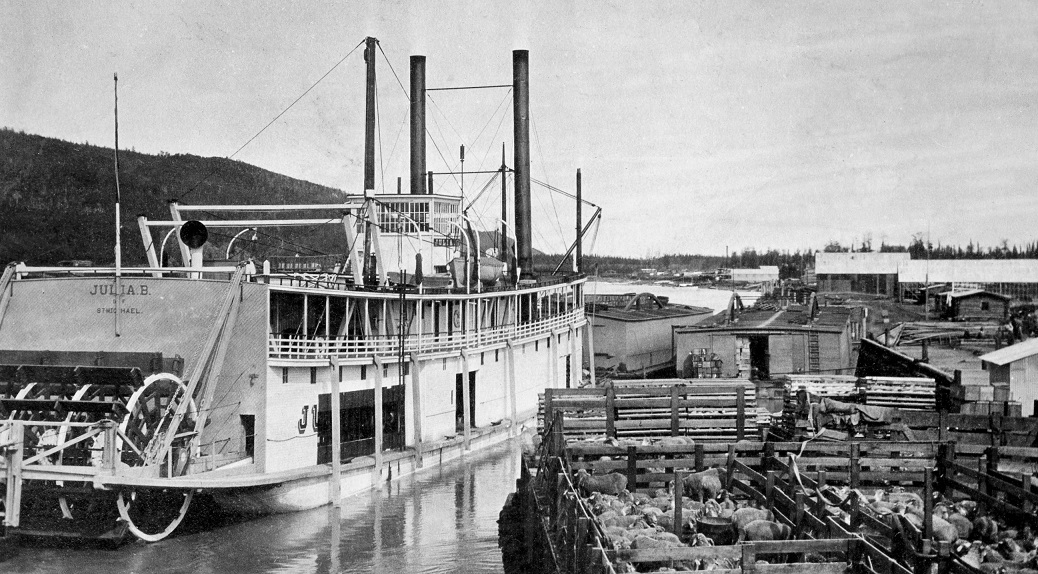
The JULIA B. (port of St. Michael) on the waterfront at Nenana for the Pacific Northwest
The JULIA B. (port of St. Michael) on the waterfront at Nenana, Alaska which is located on the Lower Tenana River at the confluence of its tributary the Nenana River. The large barge to the right of the steamboat is loaded with sheep in pens. The identification of the location came from the back side of this photo on which is written in ink: "A 'boat day' on Nenana's Waterfront"
The following history of the JULIA B. came from The Yukon River Sternwheeler Graveyard at Dawson City, Yukon by Murray Lundberg:
The JULIA B. was a wooden sternwheeler, built in 1908 at Ballard, Washington by Cook & Lake, for the Merchant's Yukon Transportation Company. She was 158.7 feet long, with a 38-foot beam and 6-foot hold. Her gross tonnage was 835.33, registered as 511.08 tons. She had one deck, 2 masts, a sharp head and square stern.
The JULIA B. was put on the ways at the Dawson Shipyards in the fall of 1924 and was never launched again.
explorenorth.com
St. Michael (the JULIA B.'s home port) is located on the east side of St. Michael Island at the southeastern end of Norton Sound in Alaska. During the gold rush of 1897, St. Michael was a major gateway to the Alaskan interior via the Yukon River Delta (located about 40 miles to the southwest). As many as 10,000 persons were said to live in St. Michael during the gold rush. St. Michael was also a popular trading post for Alaska Natives to trade their goods for Western supplies.
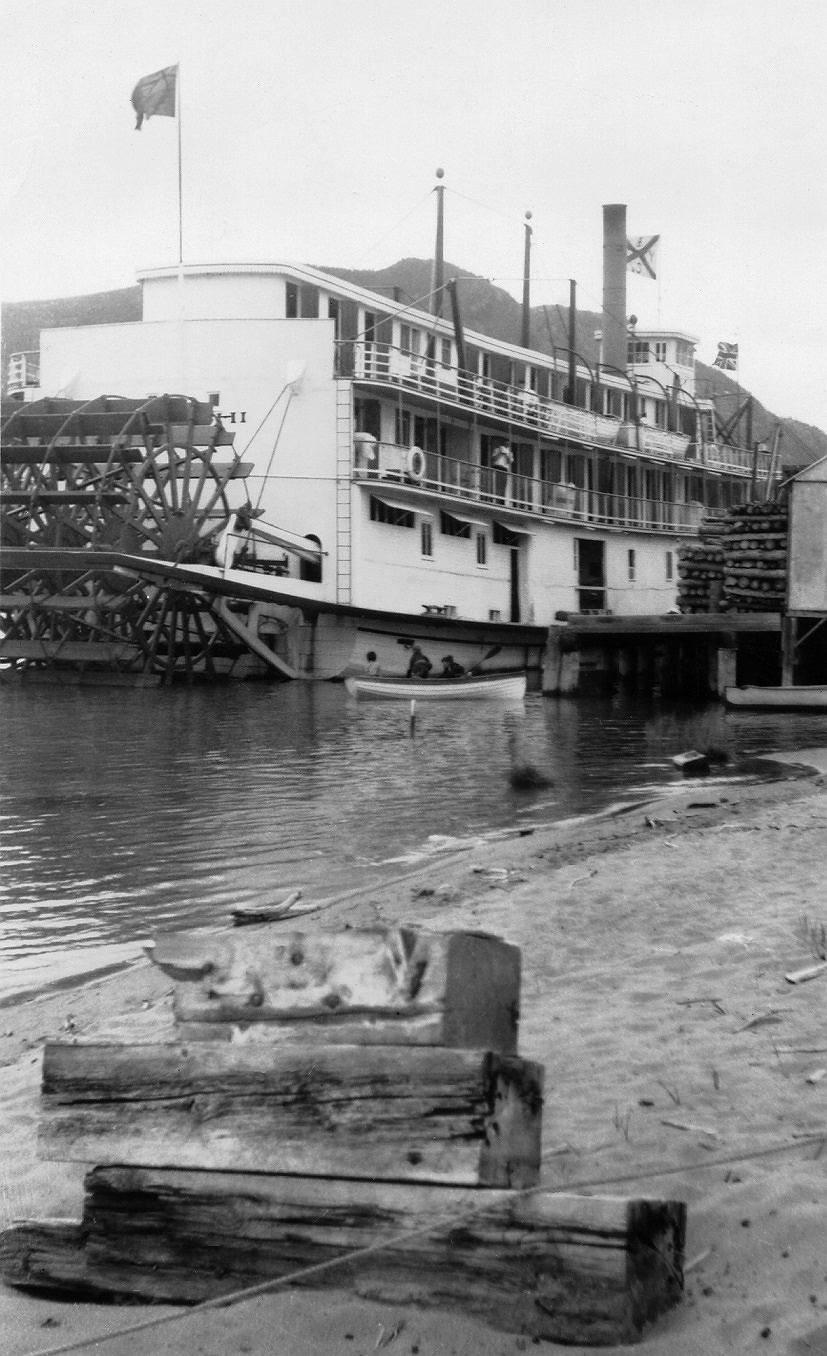
The large pieces of abandoned wood in the foreground were likely wharf pilings which had been removed after they had gotten water logged and needed to be replaced with new lumber.
Jim Hale was able to identify the boat in the snapshot.
It was the TUTSHI 1917-1990
The TUTSHI's biography is on steamboats.org.
S. S. TUSTSHI was launched in June 1917 by the British Yukon Navigation Company. The boat was 167 ft. long and held 110 passengers. Over the time more staterooms had been added on the texas deck to accomodate more passengers.
Built especially for the tourist business on the Southern Lakes (lakes right next to Carcross: Tagish Lake and Atlin Lake) she had a keel instead of a flat bottom like the riverboats on the Yukon River.
mainly served as a pleasure boat for cruise ship passengers arriving at Skagway, AK, and being transferred to Carcross by railroad. But occasionally she also carried mail and freight.
In 1925 the TUTSHI, originally build to be fired by wood, was converted so she could now burn oil as well. In 1955 her career ended and when she was hauled out of the water.
1972 the steamer was acquired by the Yukon government and restored. In 1990 a fire destroyed most of the TUTSHI. Today, the remains of this tragic fire are on display at Carcross, Y.T. right next to the Whitepass and Yukon Railroad station.
The exhibit features most of the machinery, especially the two steam engines, boiler, metal parts of the paddlewheel and the front part of the hull.
S. S. TUTSHI
Carcross, Yukon Territory
Y0B 1B0, Canada
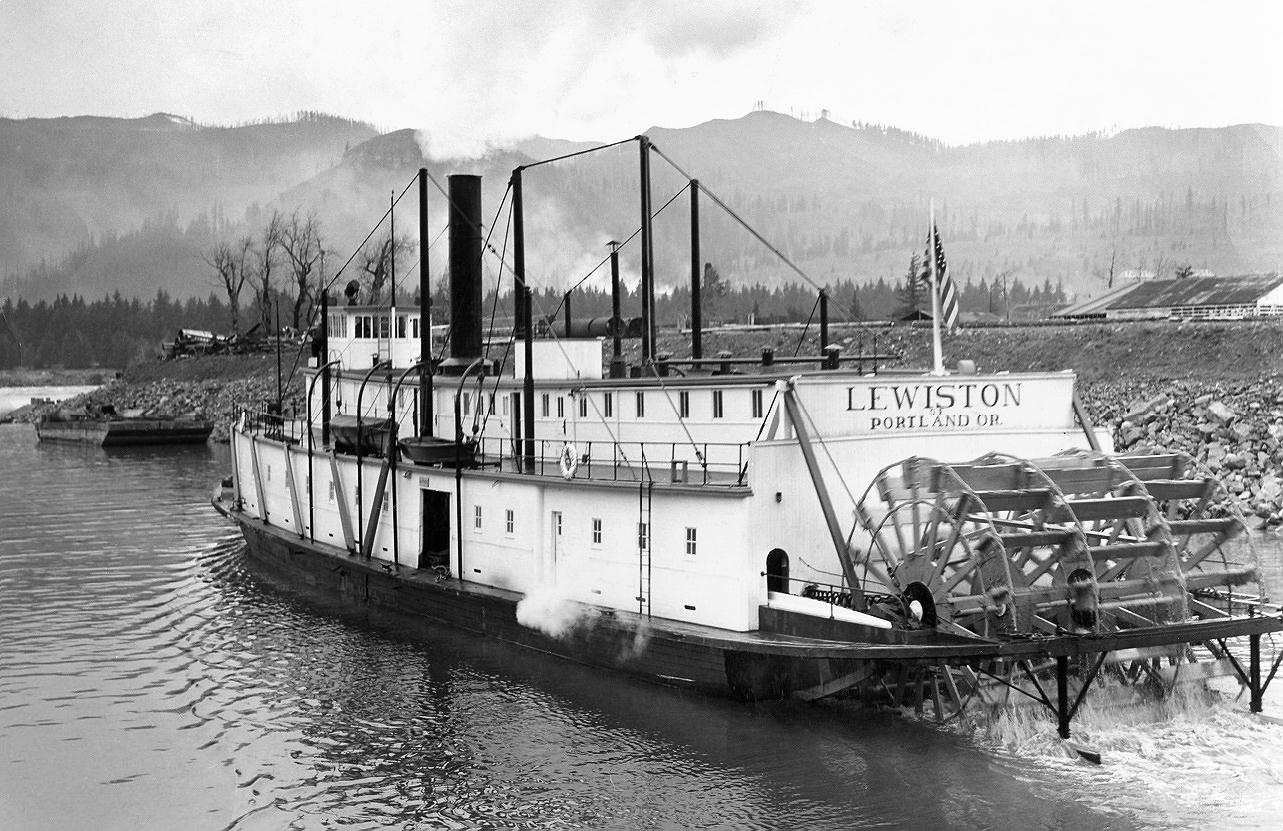
Steamer Lewiston on the Columbia River
Attached file scanned from a nice sharp 8 x 10 photo just delivered today . . . there was some information written on the back as to date, location etc. to which I added a brief Wiki paragraph on the Snake River.
The Steamer LEWISTON passing through Bonneville dam locks on the Columbia River en route to Portland, Oregon on March 6, 1940. while it was being brought down for the last time, after having served as the final paddlewheeler to operate on the Snake River.
Wikipedia
"At 1,078 miles long, the Snake River is the largest tributary of the Columbia River, which is the largest North American river that empties into the Pacific Ocean. Rising in western Wyoming, the Snake flows through the Snake River Plain of southern Idaho, then through the rugged Hells Canyon area via northeastern Oregon and the rolling Palouse Hills, to reach its mouth near the Washington Tri-Cities area, where it enters the Columbia River."
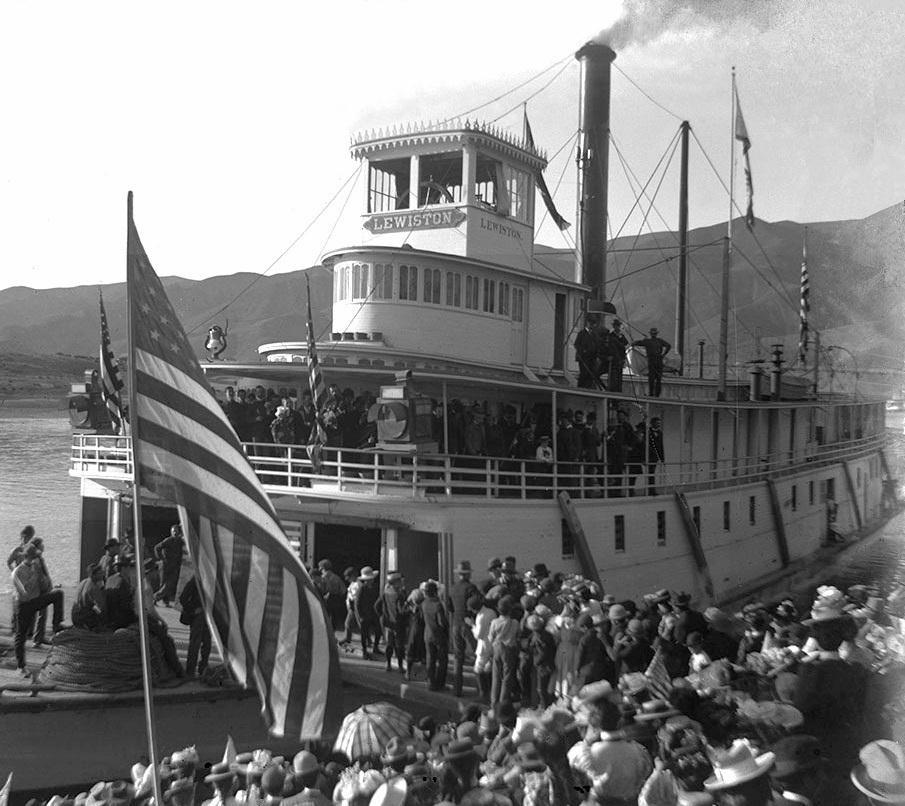
We received this image from a collector who found it on a glass negative. He scanned it and gave us permission to post it here. Dave Thomson identified four boats named Lewiston, all from the Northwest. This is one of the earlier Lewistons.
Lewiston (1867) Umatilla, Oregon
Lewiston (1894) Riparia, Washington
Lewiston (1905) Riparia, Washington
Lewiston (1923) Linnton, Oregon
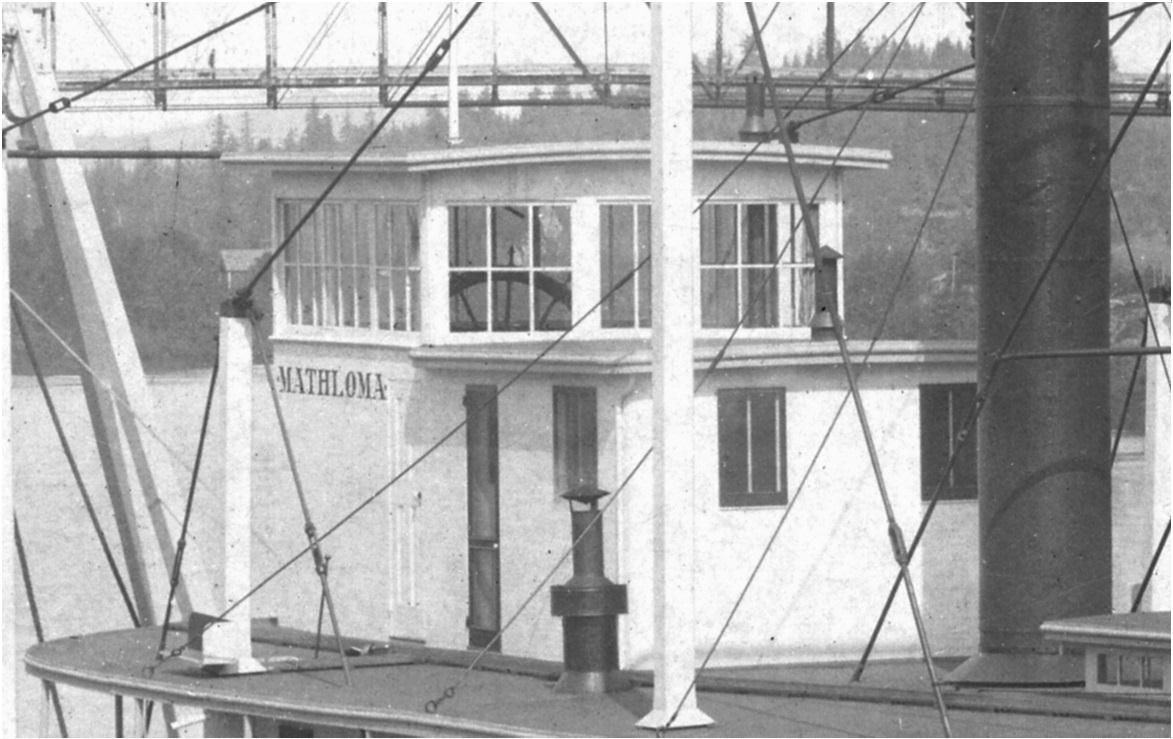
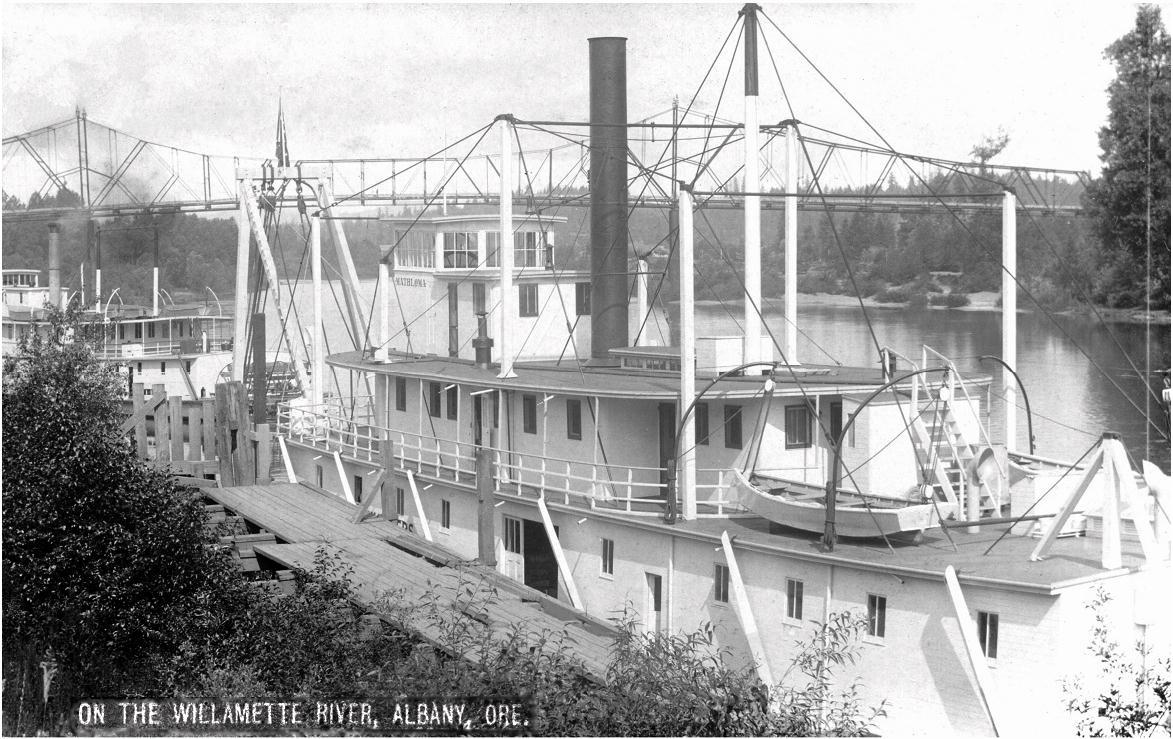
A neat photograph of the government snag boat MATHLOMA on the Willamette River, OREGON circa 1900.
The original real photo postcard is a faded sepia so it's difficult to bring contrast back to it but by converting the file to grayscale and adjusting the saturation it improved it somewhat. Included detail of the pilot house where the boat's name is easier to read.
Some additional history about the MATHLOMA has been provided by Jim Hale who found it for us in the book "Stern-Wheelers Up Columbia: A Century of Steamboating in the Oregon Country" by Randall V. Mills Pacific Books, 1947:
"THE MATHLOMA WAS BUILT IN PORTLAND, OREGON IN 1896 AND LASTED UNTIL 1927."
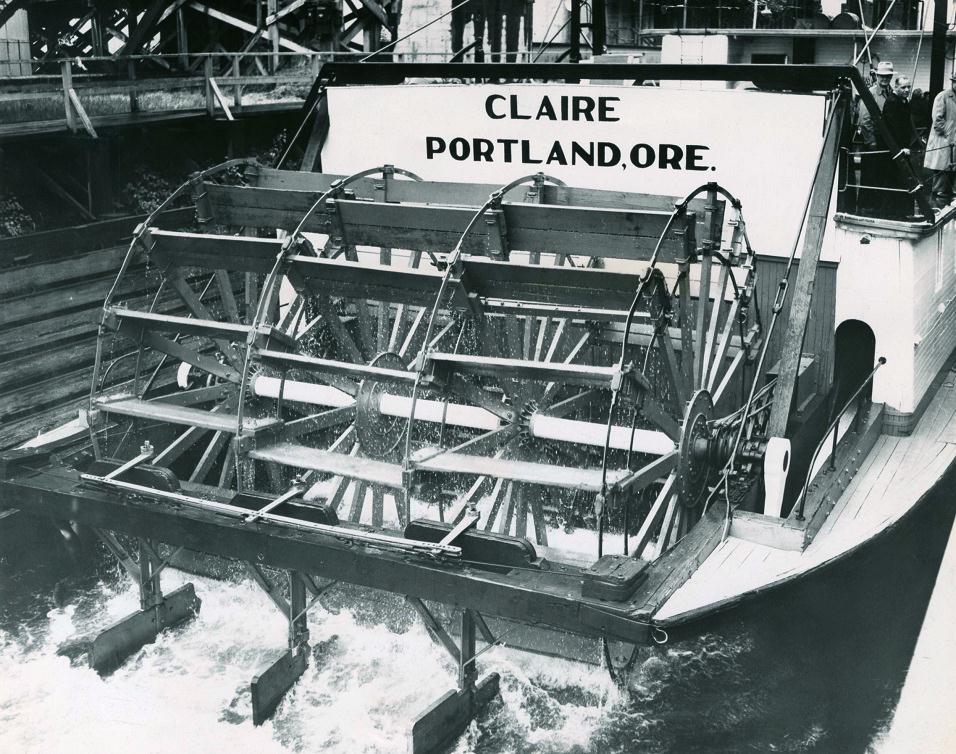
Sternwheeler CLAIRE of Portland, Oregon in 1952
Columbia River steamer CLAIRE was built in 1918 563 tons 157 feed long
8 x 10 press photo
Rubber stamp dated June 30, 1952
Caption that was published in newspapers with this photo:
"Big paddle wheel which propels CLAIRE turn slowly, moving steamboat a slow speed through first lock stage as Oregon City. Steamboat proceeded though locks in 40 minutes."
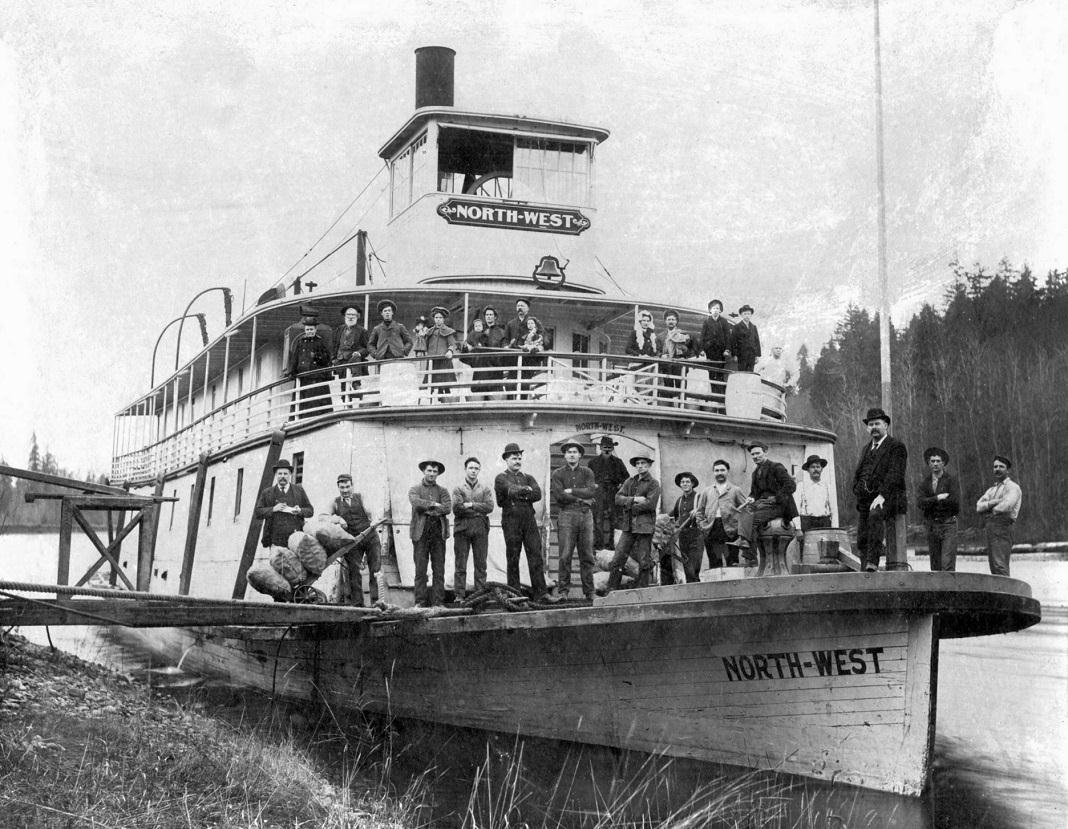
Steamboat North-West
A motley crew on deck below and diverse passengers above on the boiler deck aboard the NORTH-WEST which came from a source in Oregon so likely navigated the Columbia River and tributaries. There was also a boat named the NORTHWEST (without the hyphen) which is remembered fondly in an extensive write-up on the internet but it must have been a much grander and prestigious steamer than this relatively modest boat.
THE STEAMBOAT NORTH-WEST SERVED ON THE SASKATCHEWAN RIVER FROM 1882 TO 1897
Wikipedia
The Saskatchewan (from the Native Canadian Cree language meaning: "swift flowing river") is a major river in Canada, about 340 miles long, flowing roughly eastward across Saskatchewan and Manitoba to empty into Lake Winnipeg. Through its tributaries the North Saskatchewan and South Saskatchewan, its watershed encompasses much of the prairie regions of central Canada, stretching westward to the Rocky Mountains in Alberta and northwestern Montana in the United States. It reaches 1,205 miles to its farthest headwaters on the Bow River, a tributary of the South Saskatchewan in Alberta.
The history below from Hudson's Bay Company Archives - Winnipeg, Manitoba CANADA
https://www.gov.mb.ca/chc/archives/_docs/hbca/ships_histories/north-west.pdf
Steamer NORTH-WEST
Sternwheeler, two decks, square stern, carval build
Designer and builder: John Irish, Moorhead, for Peter McArthur
Built in the Spring of 1881, for $27,000.00
Dimensions: Length - 200'; width - 33'; hold - 4.5' Draft: 305 Tons
Number of passengers: 80 berths
Power: two horizontal non-condensing engines, Pioneer Iron Works, LaCrosse, Wisconsin 1882, 15 March Sold to North-West Navigation Company, towed by Princess to Grand Rapidsafter making 8 trips
1882 season Repaired, owned by Winnipeg & North Western Transportation Company, made three trips for HBC before winter 1883. Had an accident at Victoria Rapids, repaired at Grand Rapids, beached at Cumberland House
1884, 16 April Bought by Winnipeg & Western Transportation Co.
1884, July Certificates of Safety issued at Grand Rapids
1885 season Served in Riel Rebellion, damaged on shoal, repaired at Prince Albert
1886 season Made three trips between The Pas, Prince Albert, Victoria, Grand Rapids
1887 season Made four trips between Prince Albert, Grand Rapids, Edmonton and Victoria
1888 season Made four trips between Grand Rapids, Prince Albert, Edmonton and Victoria
1889 season Made one trip between Cumberland, Grand Rapids, freight by York Boat to Prince Albert
1890 season Made two trips between Cumberland, Grand Rapids, Edmonton
1892 season Made two trips between Prince Albert and Grand Rapids
1893 season Made four trips stopping Fort Pitt, The Pas, Grand Rapids, Prince Albert
1894 season Made three trips stopping Fort Pitt, The Pas, Grand Rapids, Prince Albert
1895 season Laid up
1896 season Repaired, made two trips between Prince Albert & Edmonton
1897 season Made three trips between Prince Albert, Edmonton, Victoria, then laid up
1898 Advertised for sale
1899 Completely destroyed by Edmonton flood, flotsam seen at Saddle Lake
1900 Attempts to salvage and sell parts of "wreck" boilers lifted from the North Saskatchewan at Edmonton, hauled by wagon to Victoria Settlement near Smoky Lake to power a saw-mill, then used to heat the new Smoky Lake Hospital
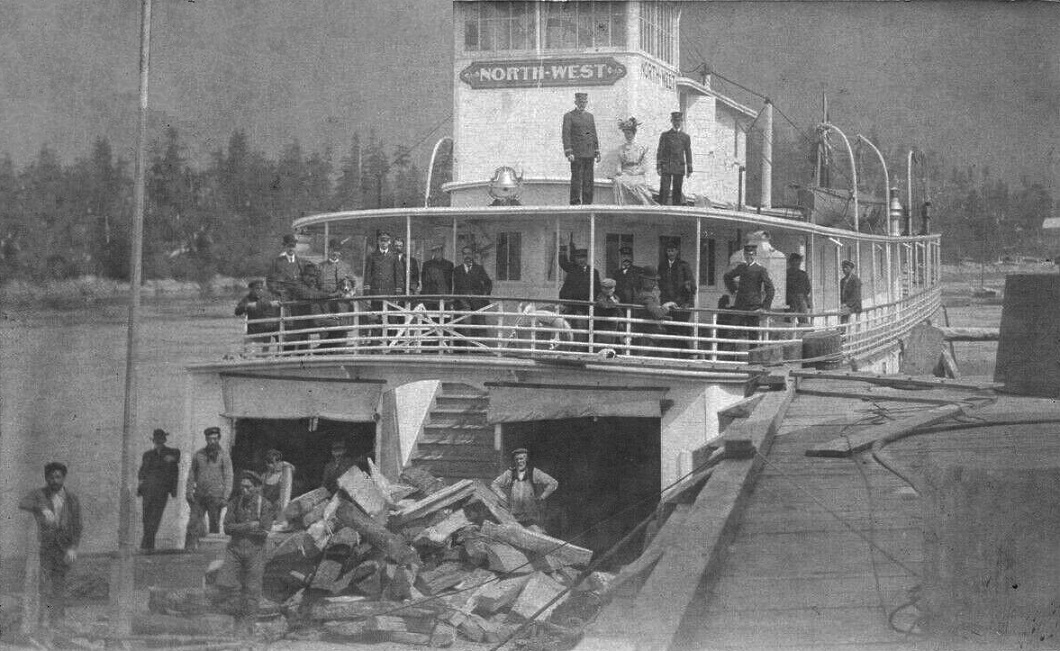
North-West Steamboat
Northwest (sternwheeler) - Wikipedia
Northwest was a steamboat that operated on the Columbia, Cowlitz and lower Willamette rivers from 1889 to 1907. In 1907 Northwest was transferred to Alaska, where it sank on the Skeena River.
This vessel should not be confused with several similarly named vessels operating at about the same time in the same region, including in particular the Northwest, a sternwheeler built in 1877 at Columbus, Washington, and dismantled in 1885.
Wikipedia
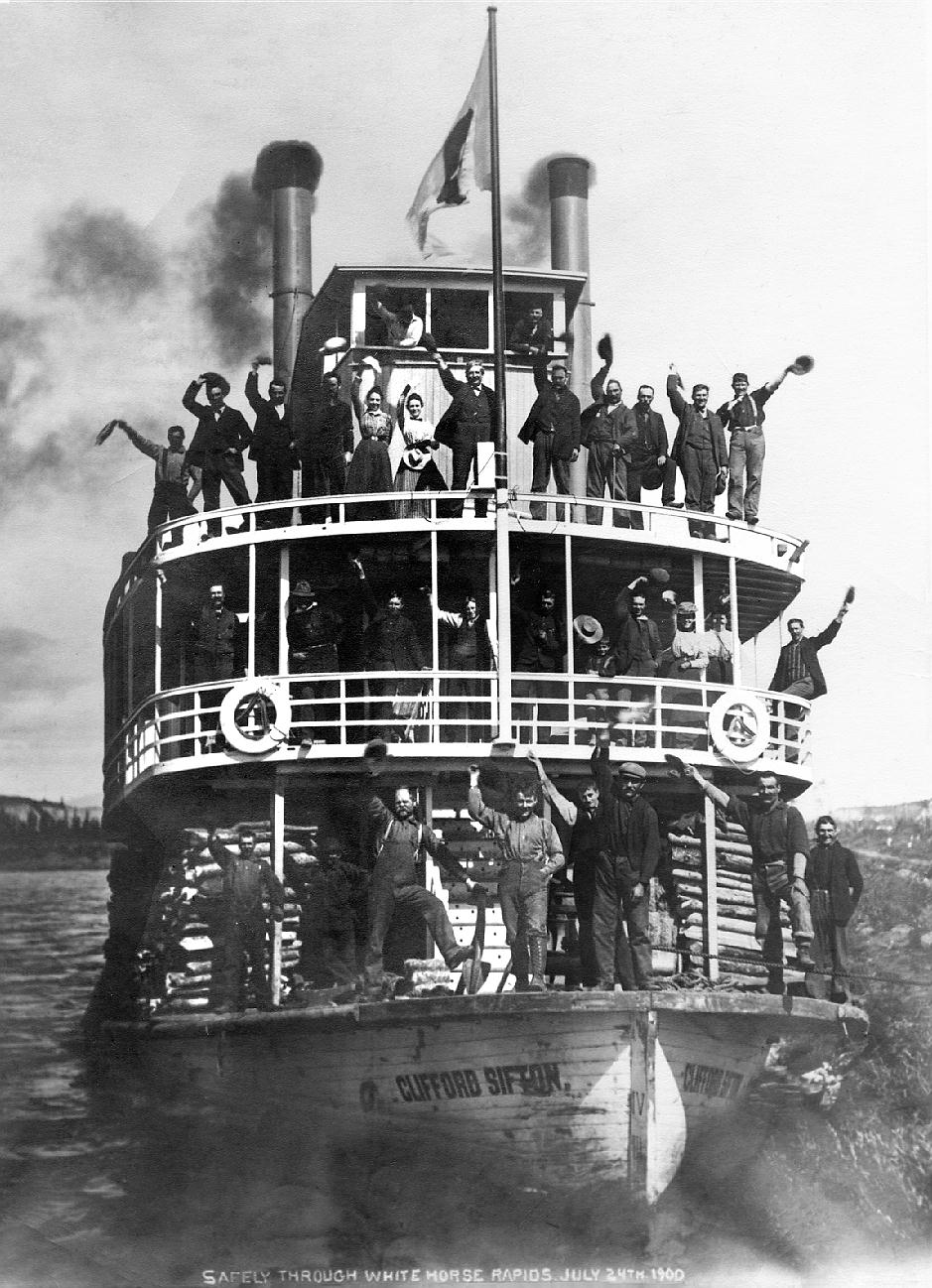
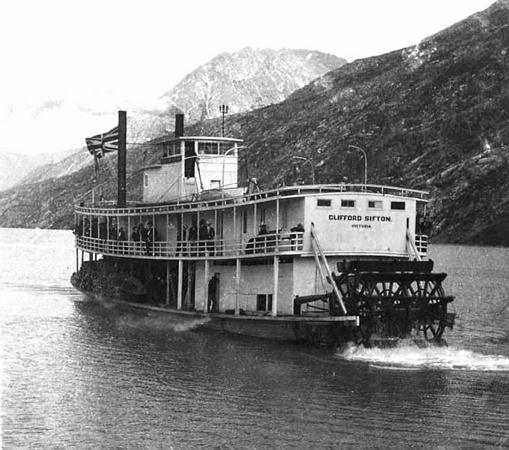
Photo from the city of Campbell River, British Columbia of the Gold Rush era Yukon River sternwheel steamboat CLIFFORD SIFTON taken on July 24th, 1900 with jubilant passengers and crew waving to the photographer after the boat had safely survived an exciting voyage through the White Horse Rapids which were submerged under Schwatka Lake after the Whitehorse Dam was built in 1958-59. The other photo is a small stern view of the CLIFFORD SIFTON with VICTORIA under her name above the paddlewheel indicating her home port in B.C.
The CLIFFORD SIFTON was built in 1898 at Bennett, British Columbia. She was 120 feet long and originally owned by Dominion Steamboat Line then acquired by the White Pass Line in 1903. She was last used as a powerboat in 1903, converted to a barge and first used at Hootalinqua in Yukon Territory in 1904. Demolished in a collision at Dawson City, Yukon Territory in 1905.
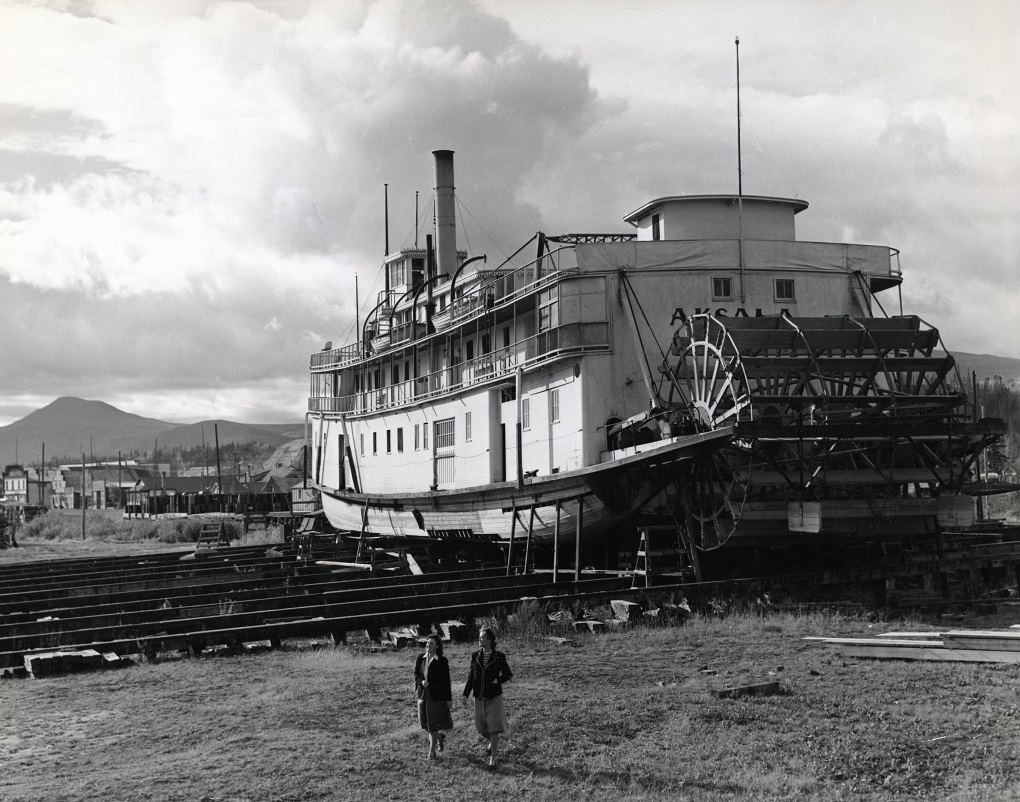
Yukon Steamer AKSALA (ALASKA spelled backwards)
Taken at Whitehorse, Yukon Territory July, 1949

Wikipedia
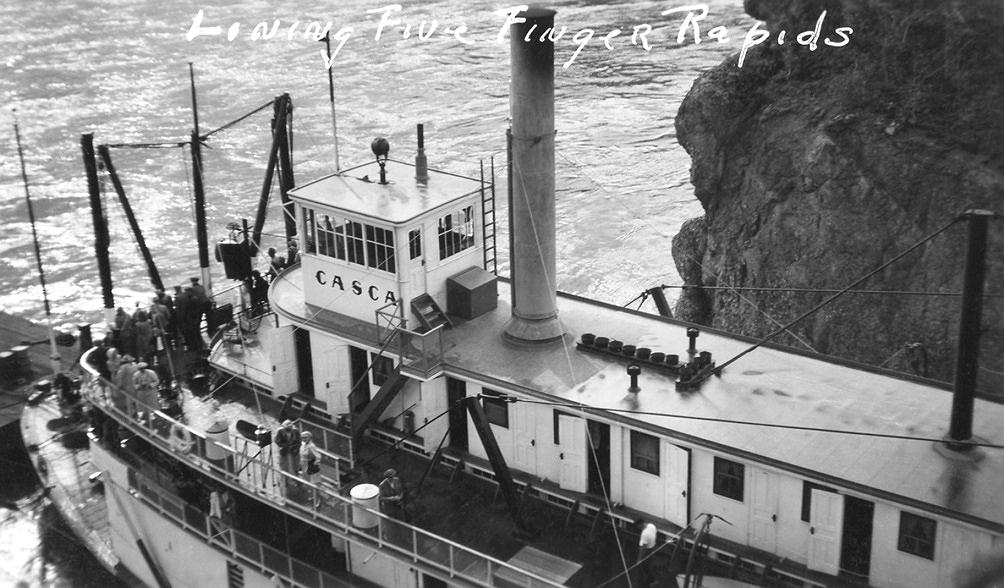
History of the steamer CASCA from explorenorth.com:
explorenorth.com
The CASCA was a wooden sternwheeler, 180 feet long, with 36.5-foot beam and 5.6-foot hold.
She had one deck, was of carvel build, with a straight head and transom stern, and had 5 bulkheads.
Over the winter of 1936-1937, the CASCA was partially constructed at Vancouver for the British Yukon Navigation Company with pre-fab units then shipped to Whitehorse for assembly; most of the boat was then built at Whitehorse
Licensed for 180 passengers in 1937, she was the plushest ship on the upper river, used for most British Yukon Navigation Company tourist runs.
On June 20, 1974, the CASCA and the WHITEHORSE stood side by side out of the water on the ways when they were lost in a fire at Whitehorse, Yukon Territory.
They were occupied by squatters at the time who probably started the the blaze by accident with a cooking fire.
Fortunately the Yukon steamboats KENO (now at Dawson City, Yukon Territory) and the KLONDIKE (now at Whitehorse) have been preserved, restored and can be visited.
Below is a portion of an informative online article about the Klondike River "Five Finger Rapid not Rapid[s]."
"Highway #2—North Klondike Highway, Km. 380 - FIVE FINGER RAPID"
sightsandsites.ca
During the 1898 Klondike Gold Rush, thousands of prospectors navigated their homemade boats and rafts 1300 800 miles from Bennett Lake to Dawson City.
Five Finger Rapid was a major obstacle along the route and more than a few stampeders ended up in the water after choosing the wrong channel.
". . . a great barrier looms up a mile ahead—five great irregular blocks of reddish rock ranging across the river like the piers of a bridge—making two principal channels. That on the left is growling ominously over shallow rocks, so we turn to the right and drop into a small eddy a few hundred feet above the great wall. We climb up and look at the rapid. It seems by no means dangerous. The opening is about one hundred feet wide, with vertical walls, through which the river drops a couple of feet, the waves rising angrily in a return curl, then dancing on in rapidly diminishing chops until lost in the swift current below."
" We turn our prow squarely for the middle of the cleft; a drop, a smash, a few quarts of water over the sides, and we are shot through into the fast current, without even looking back."
Tappan Adney, The Klondike Stampede.
Vancouver: University of British Columbia Press
Navigation
Only one of the Five Finger channels was deep enough for the sternwheelers, but the current remained very strong.
At low water, the boats could steam right up and through it.
At high water, the falls created a 1 to 2 foot shelf.
A sternwheeler ascending the rapid could only move up over the shelf until the wheel lifted out of the water and then the vessel lost power.
A cable was attached to the rocks so sternwheelers could winch themselves up stream.
It took 15 - 20 minutes for a power-capstan on the deck to pull the sternwheeler through the channel.
In 1903, the sternwheeler Mary F. Graff touched bottom at Five Fingers and cracked several hull frames.
In 1911 there were complaints that nearly every season there was an accident caused by a steamer striking the rocks at Five Finger.
Blasting work started at Five Finger in 1900 and continued until at least 1927.
Rock was removed and the channel widened by 20 feet. . . .
The Five Finger islands and riverbank are composed of conglomerate rock (pebbles and boulders embedded in a sand-to-mud matrix) that is more resistant to erosion than surrounding mudstone layers.
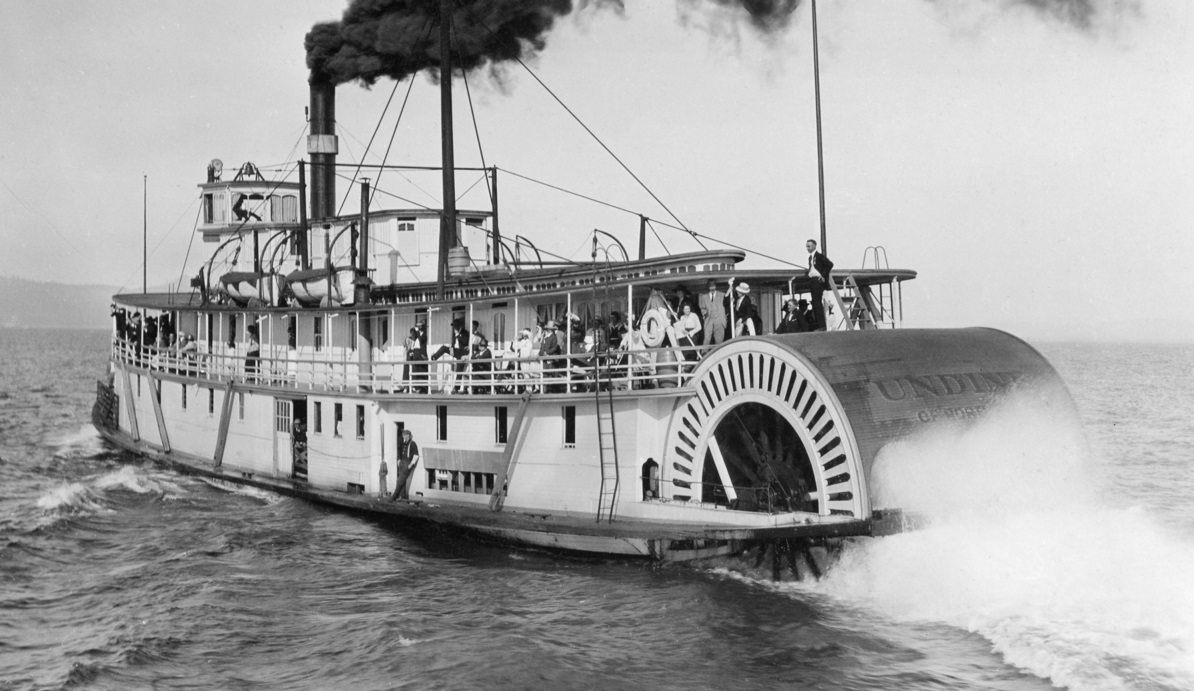
Columbia River sternwheeler UNDINE circa 1915
Canada across the border to the north had a great deal of steamboat commerce on its lakes and rivers and especially on the Yukon River during the Gold Rush while in the U.S. territory of Alaska the Klondike River transported gold seekers, supplies and necessities of life to frontier settlers who would not have been otherwise reliably connected to the outside world.
The sternwheeler "Undine" on the Columbia River
April 29 - May 3, 1915
columbiariverimages.com
With more than 100 people aboard, the sternwheeler "Undine" was the first steamer to travel on the Columbia River from Portland, Oregon, to Lewiston, Idaho, during the week-long celebrations of the opening of The Dalles - Celilo Locks and Canal.
The "Undine" was the flagship to a long string of vessels participating in the celebrations. She left Portland, Oregon at 1 a.m. on April 30th and arrived in Lewiston, Idaho on the morning of May 3rd. On the return trip she led the "fleet" from community to community to participate in canal opening celebrations.
Contemporary newspaper account from "The Sunday Oregonian", May 9, 1915:
"... The Undine party left Portland at 1 o'clock Friday morning, April 30. The vessel passed through the Cascade locks at 6 o'clock in the morning and reached The Dalles about 10 o'clock. The vessel was delayed there for several hours on account of high winds, but about 3 o'clock in the afternoon left on the up-river journey. It took about four hours to go through the locks and waterways. The Undine's first stop was at Maryhill, Washington. The Undine reached Pasco, Wash., on Saturday night, with a brief call at Umatilla, Oregon in the afternoon.
On Sunday night they stopped about three miles below Almota, Washington after calling at Riparia in the afternoon for copies of The Sunday Oregonian.
At 10 o'clock Monday morning the Undine reached its objective point Lewiston, Idaho...
The Undine, followed by the steamer J.N. Teal and the Government vessels ... left at daybreak the following morning for the festivities at lower river points. ..."
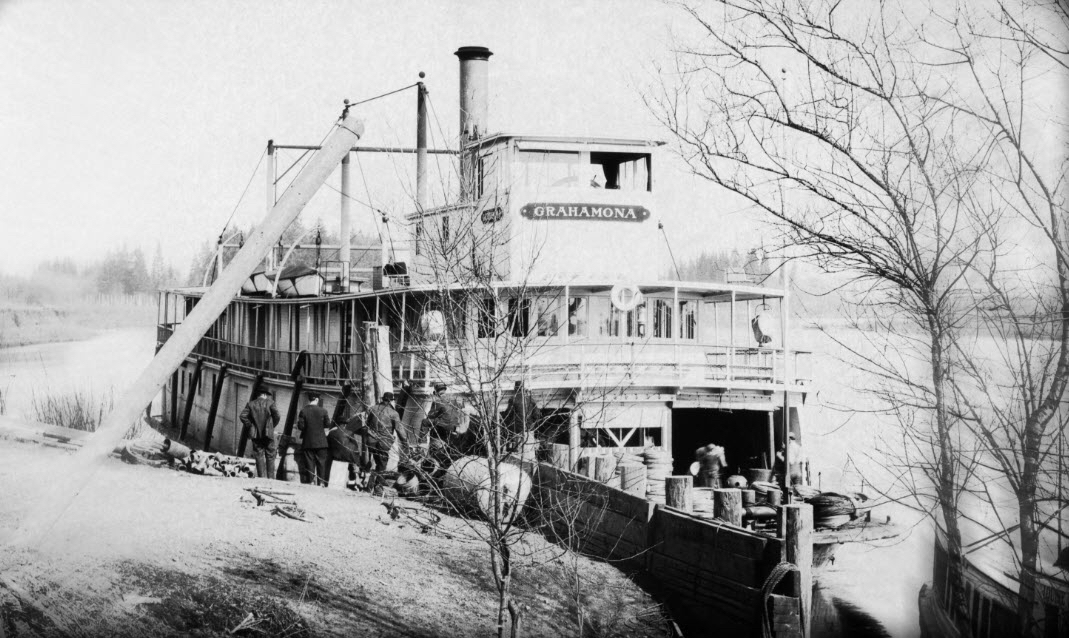
The GRAHAMONA built in 1912 for the Oregon City Transportation Company
ONE THE BACK OF THE ORIGINAL PHOTO IS WRITTEN THE LOCALE: "ALBANY" - LOCATION OF THAT TOWN AND LANDING AS FOLLOWS:
Photo circa 1912 taken of the GRAHAMONA on the Albany, Oregon landing at the confluence of the Calapooia River and the Willamette River, just east of Corvallis and south of Salem.
The GRAHAMONA
U.S. Steamboat registry #210453
Sternwheeler
Wikipedia
Built by Joseph Supple at Portland, Oregon in 1912 for a total cost of $35,000 for the Oregon City Transportation Co., to serve in their Yellow Stack Line. The boat was especially designed to serve on the shallow waters of the upper Willamette River; one of the largest steamboats ever to operate there and later would navigate on both the Columbia and Snake Rivers for the Inland Empire Truck & Boat Co. and the Portland Navigation Co. In 1920 the GRAHAMONA was sold and her name changed to the NORTHWESTERN. In 1939, the vessel was sold again, and transferred to Alaska for service on the Kuskokwim River. By 1949 she was out of service and was abandoned on the riverbank at McGrath, Alaska.
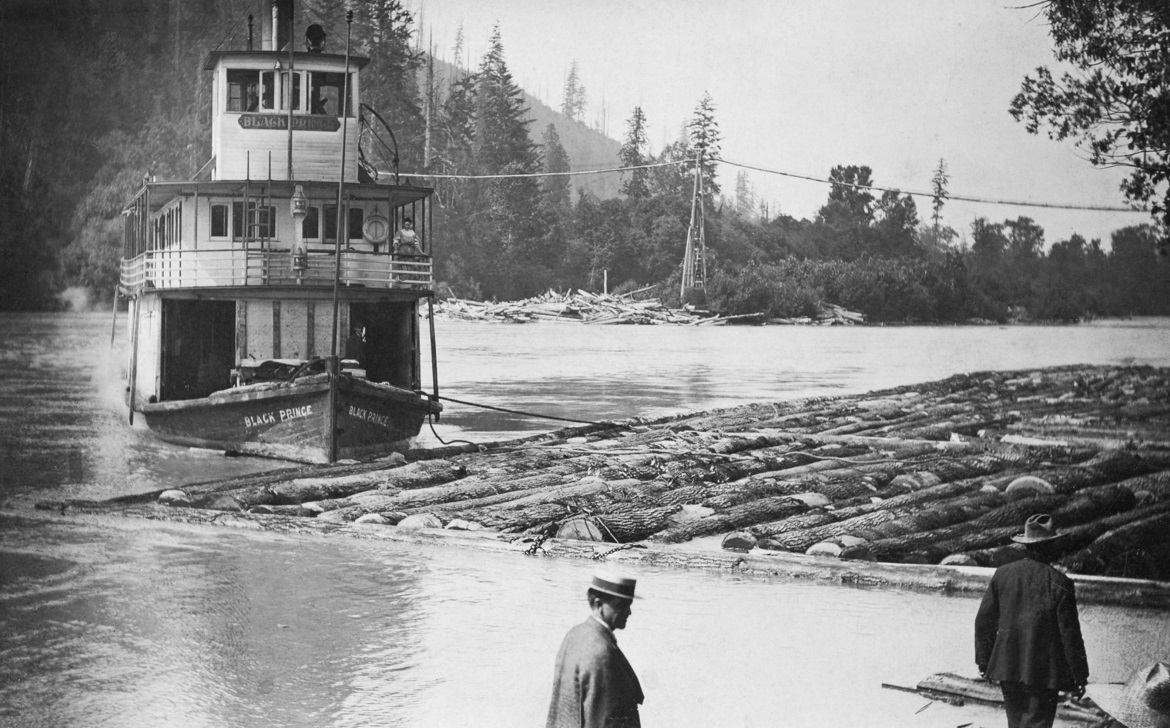
Skagit River sternwheeler BLACK PRINCE
The BLACK PRINCE on the Skagit River in Washington State
The following story and others about the BLACK PRINCE can be found at this link: stumpranchonline.com
BLACK PRINCE sternwheeler by Ray Jordan
Though half a century has passed, nostalgic twinges grip the writer at times as he seems to hear the melodious whistle, faint and far away, of the old sternwheeler BLACK PRINCE as she boils up the Skagit River in Washington state with cool-headed Captain Forrest Elwell at the wheel.
Highlights of the career of the historic steamer were contained in a letter sent by Captain Elwell to the Skagit Valley Herald in 1964.
Captain F.M. Elwell, aged 84 in 1964, resided in Everett, Washington. Elwell's last tour of duty before retiring was with the Black Ball Line as Captain of one of the large ferries on Puget Sound.
Ray Jordan wrote the following which included excerpts from Captain Elwell's letter in quotation marks. This was published October 7th, 1964 in the Skagit Valley Herald:
"In the summer of 1900, Captain Charles Wright sold the City of Bothell and then the Snohomish and Skagit River Navigation Company was formed by Captain Charles Wright, Captain Charles Elwell, and Captain Vic Pinkerton. It was then decided to build a boat for towing on the Snohomish and Skagit rivers. Captain Charles Elwell made the hull model and Bob Houston was given the job of building the BLACK PRINCE."
Dimensions of the steamboat were: hull, 93 feet; over-all length, 112 feet; beam, 19 feet; depth of hold, 5 feet; tonnage measurement was 159 gross tons, according to the captain. When the hull and the superstructure were completed, she was towed to Seattle by the tug NELLIE PEARSON, where a pair of 10 X 48 steam engines and a 100 horsepower brickyard boiler, 150 working pressure, were installed.
"After completion, the Prince came back to Everett under her own power and then went to the Skagit to tow logs and pilling," Elwell wrote.
The first crew on the Prince in 1901, was Captain Elwell; Captain (Engr.) Wright; engineer Mike Hertzberg; Captain Pinkerton; Forrest Elwell, deck hand, and Wes Harbert, fireman.
"In the late summer of 1901, she made a trip between Novelty and Tolt. In 1902, the Prince took a two from Haskell Slough (near Monroe) to the mouth of the Snohomish River.
"On July 7, 1903, loaded 50 tons of machinery at Mount Vernon designated for the old Talc Mine about 12 miles above Marblemount. ( A former employee of the talc mine remembered the date as 1906. The distance was estimated in river miles. Mileage by automobile is about 6 miles. This trip took three days to get up the river and unload," the Captain continued.
To negotiate Stick's Riffle (named for the old Indian, Johnny Stick, who lived there) below Bacon Creek, the crew found it necessary to pay out 1200 feet of line and employ the boat's winch to pull the heavily laden PRINCE over this shallow, swift piece of water.
"Before this trip was made, Captains Wright and Elwell decided to decrease the diameter of the paddle wheel by about one foot. This was done to give a little more power on the wheel. "They also set up the safety valve another 10 pounds, carrying a boiler pressure of 160 pounds. After this trip, the wheel a safety valve were returned to their original settings."
This trip by the BLACK PRINCE may have been the farthest upstream penetration of a steamer sine the gold rush of 1880. One sternwheeler, the CHEHALIS, is reported to have reached the Portage, a mile or more above the old talc mine, during the gold excitement. One old-timer, who has lived on the river since 1877, is inclined to believe this. He says that a river-wise boat captain conceivably could have made it over the riffles above the talc mine during real high water. He added, however, that most of the gold rush steamers got no farther than Durand Riffle, a mile or so below Marblemount.
"In 1906, the Company operated a logging camp across the Skagit from Birdsview The logs were towed to the mouth of the Skagit and later to Utsaladdy by the PRINCE."
"The writer well remembers towing from Birdsview, and especially through the Dalles (above Birdsview) which is like the letter 'Z'. If you were lucky, okay, but if the raft broke up, you were in a mess, as logs would be all around and under the PRINCE, which would almost spin like a top.
"I also remember a trap (fish trap) pile that went through the bow, and as luck would have it, the pile tore a hole in the forward tank, or else the boat would have sunk. The PRINCE ran on the Skagit for some time before this hole was fixed."
"The first time (after the damage was done) that she took a tow to Utsaladdy, they put the PRINCE right on the beach and when the tide went out the hole was repaired."
In 1910, the Company sold the PRINCE and the T.C. REED to Elwell, Pinkerton, Ira Hall and Tom Meagher, who organized as the Washington Tugboat Company. Forrest Elwell was master of the PRINCE from 1907-1922.
Before the year of 1910 was out they sold out to the Puget Sound and Baker River Railroad (the logging line that hauled Dempsey and Lyman Timber Company, and later, Scott Paper Company logs down the river).
How the BLACK PRINCE got her name: Captain Wright had a dream that he had a boat that was all black and called the BLACK PRINCE, so that is where her name came from, Elwell recalled.
An excerpt from a paper read to members of the Everett Yacht Club reveals the fate of the colorful BLACK PRINCE:
"In 1922, Captain Harry Ramwell of the American Tugboat Company purchased the BLACK PRINCE. She was sold to the Everett Port Commission in the year of 1935 for one dollar. The Port Commission then turned her over to the Everett yacht Club."
"Time marches on and we found that the BLACK PRINCE was too small, too old, and too expensive to repair. She was dismantled in the late fall of 1956 to make room for a larger clubhouse." "As a memorial to the sternwheeler days, the paddlewheel of the BLACK PRINCE sits on the lawn of the Port Commission Office on the Everett waterfront."
The Echo
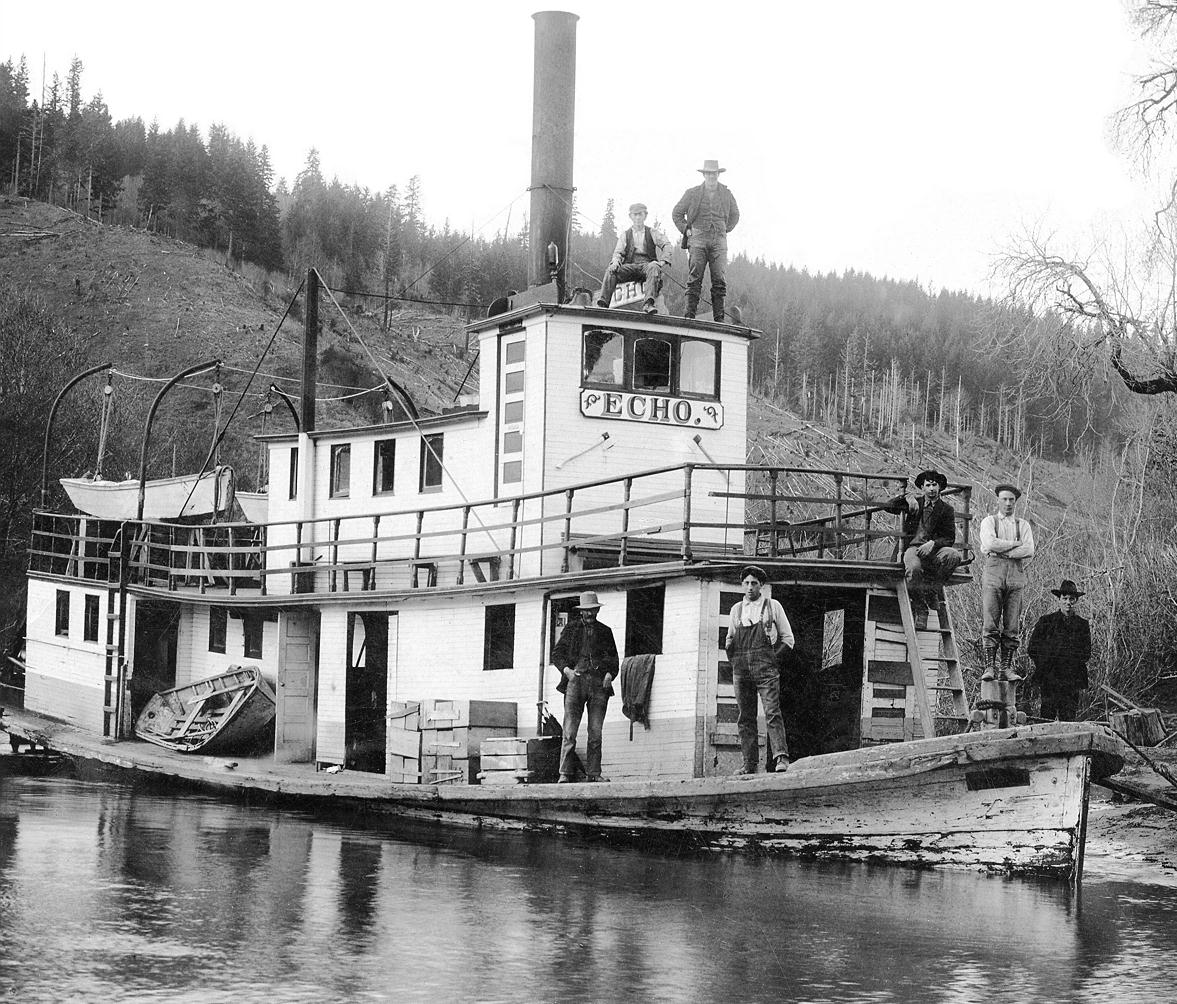
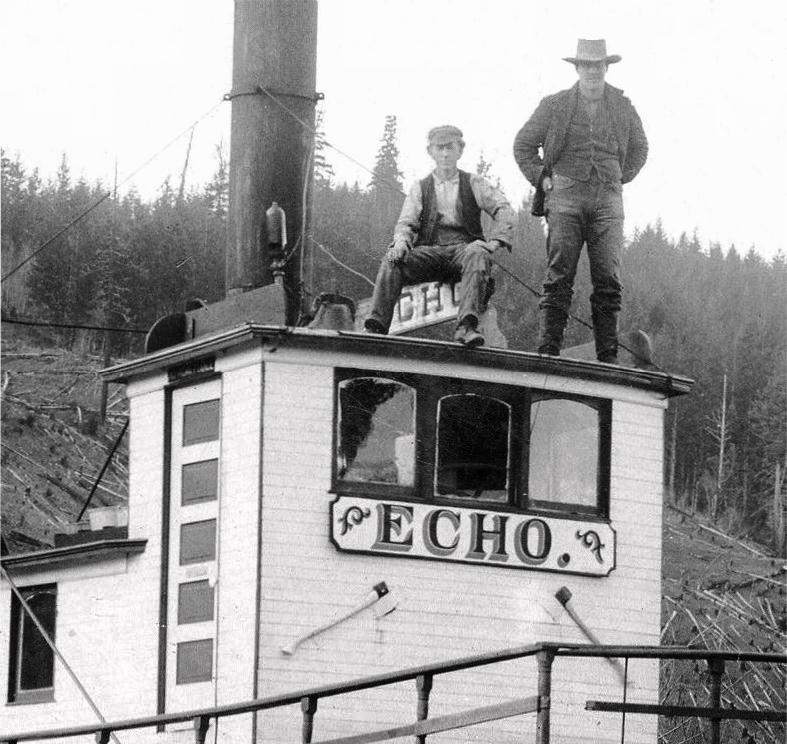
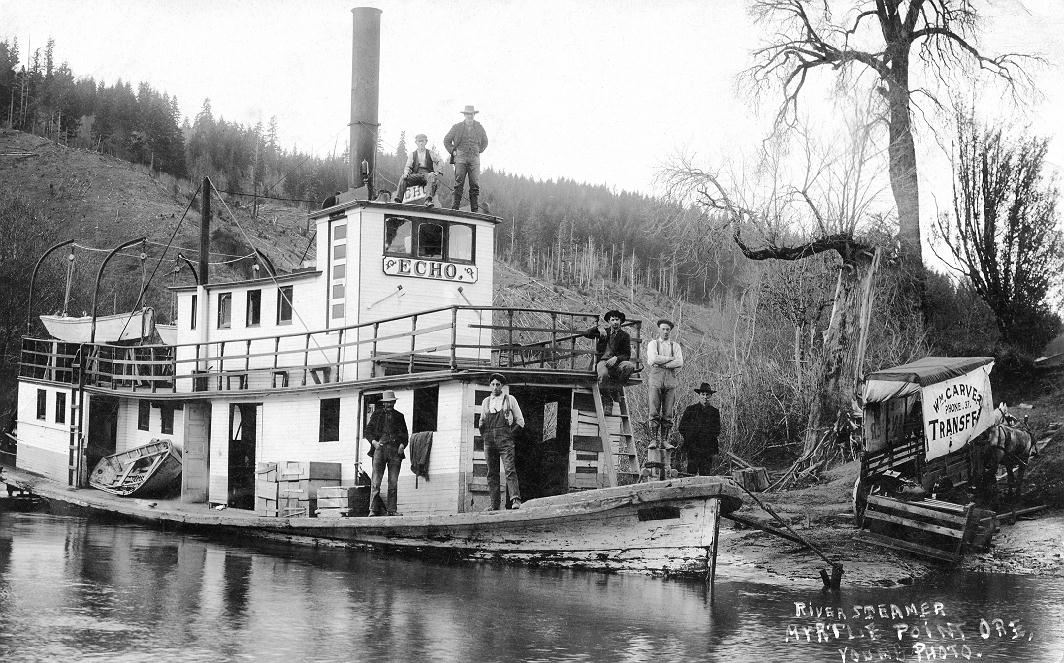
Postmarked April Fool's Day 1903 and addressed to Pearl Briggs, Coquille, Oregon. The sender was the guy standing on the bitts but I removed the word "ME" that he wrote next to himself. He didn't sign his name to the card. What flavor, a great cast of characters.
Canvas cover on the side of the delivery wagon on the right says Wm. Carver Transport / Phone. 37.
Second file is of my favorite detail of the 2 gents on top of the pilot house. The man seated is wearing a cap, suppose he could have been the pilot.
Some historical background to accompany the ECHO photo . . . adapted from this link - click here.
Myrtle Point, Oregon
Said to be one of the best-preserved small towns in Southern Oregon, Myrtle Point is at the southern end of the Coquille River Valley, about 25 miles inland from the Oregon Coast. The historic downtown district is ringed by many vintage homes, some well kept and others in the process of restoration.
The town sits along Highway 42, a major east-west route between US 101 and Interstate 5. Highway 42 S, which branches off Highway 42 in Coquille, provides an easy route to the Pacific Ocean at Bandon.
The annual Coos County Fair is held in Myrtle Point. It has been held yearly since 1912 and only cancelled once, in 1942 during the war.
The town's main event is the Harvest Festival, usually the last weekend in September.
The town is home to the Coos County Logging Museum, open in summertime. The museum is located in a domed, pioneer-era building with unusual acoustics.
Myrtle Point's boom years came in the late 1890s, when speculation ran high about a railroad connection to Roseburg. The railroad eventually chose another route, but the region's rich timberlands and farmlands sustained the community.
The town is adjacent to the Coquille River, which rises from the nearby Coast Range and finds its way to the sea at Bandon.
Once an important waterway for frontier-era commerce and transportation, the river is a popular fishery for salmon and steelhead.
The Coquille River Valley remains a productive cattle and dairy region, and there are sawmills and other small industry. Pride in a hard-working pioneer heritage runs high, and the town strives to maintain its downtown district and small-town character.
Wikipedia Echo sternwheeler built 1901 in Coquille, Oregon built by Ellingson. 76 tons; 66' length; fate unknown, probably abandoned 1911.
Sent: Tuesday, January 17, 2012 11:49 PM
Subject: photo of the ECHO
Dave, My name is Diana James. We have this same photo.
Printed on the back is words written by Pearl James, my husbands Grandmother:
"This is our boat. Charles Zevely (Known as Chas) is standing on the bow with his arms folded. Charles Henry James is sitting up on the pilot house and the boy on his left is Captain Jack."
Pearl's maiden name was Zevely so Charles must have been her brother. Charles James was her husband. The couple were quite the pioneers and had 11 children. Charles Henry worked in gold mines in California and also lived in Alaska for a while. The last of the old pioneer homestead is on the Rogue River.
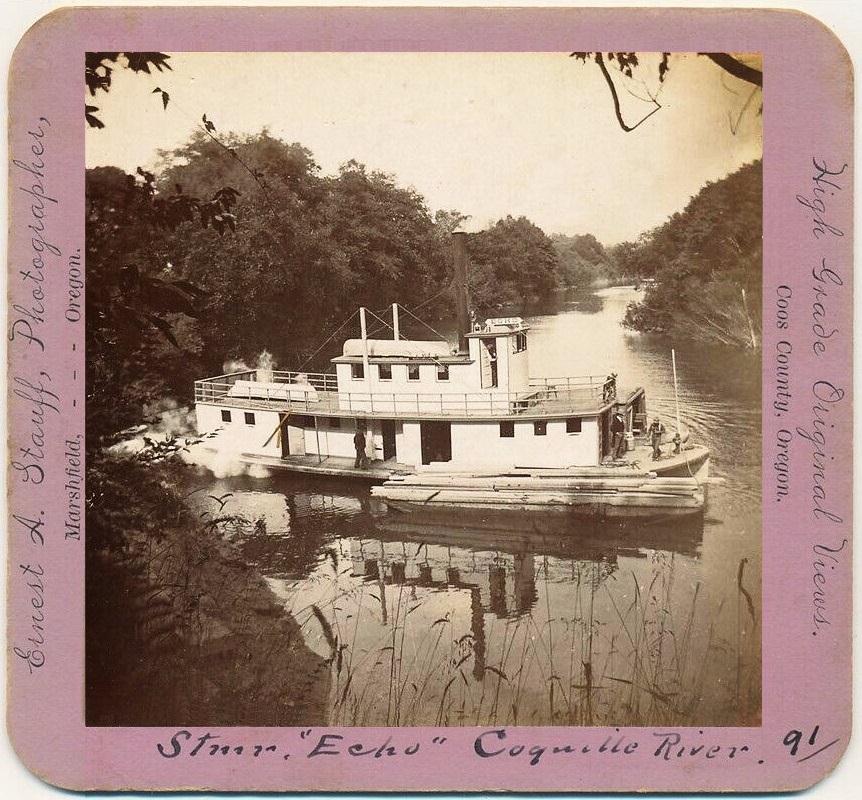
1891 Stereoview of the Echo

With the exception of images credited to public institutions,
everything on this page is from a private collection.
Please contact Steamboats.com for permission for commercial use.*
All captions provided by Dave Thomson, Steamboats.com primary contributor and historian.
